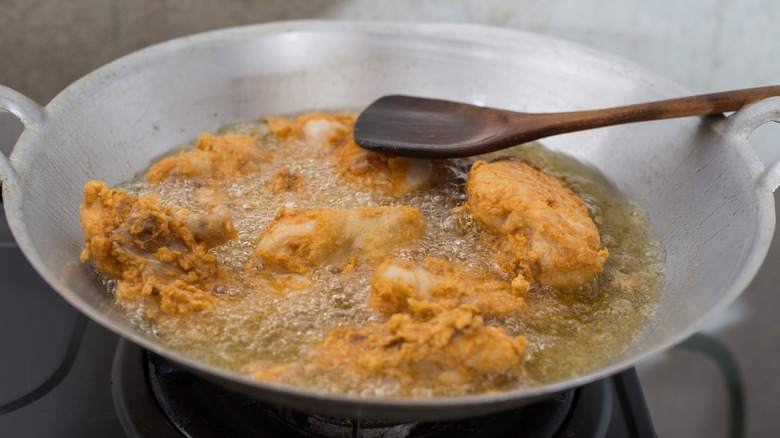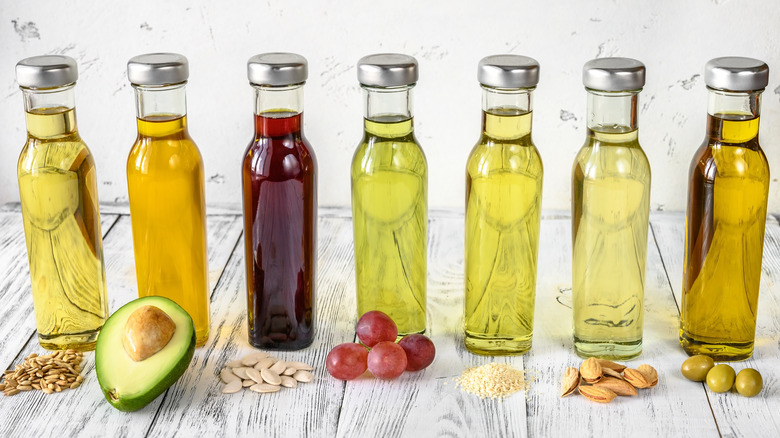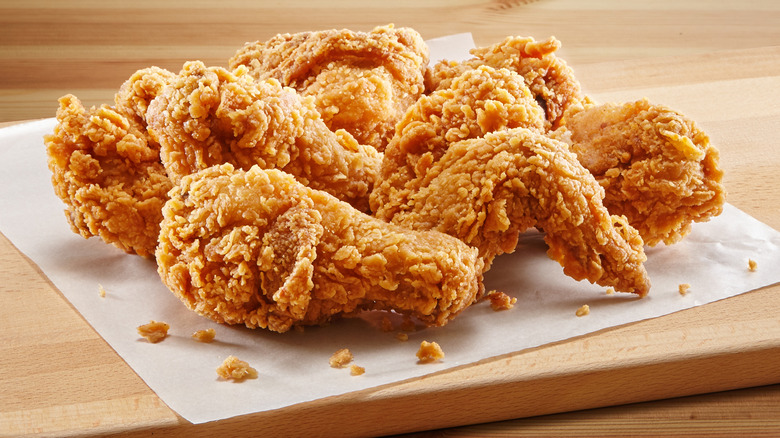It Pays To Skip The Olive Oil When Frying Chicken
Fried chicken. Just the words evoke such meaning. There's nothing better (unless you're a vegetarian) than biting into a hot, crisp piece from your go-to spot. The crisp browned skin, the juicy and tender meat, and the fabulous rich flavor are practically irresistible.
But there's a catch or two. Frying chicken at home is no easy feat. There are some rules to follow; for instance, the chicken should be cut into drumsticks, breasts (cut in half), thighs, and wings, so that it fries quickly and cooks through before the skin gets too brown, per The New York Times. The chicken should not be ice cold when you fry it. And naturally, the oil must be at a certain temperature. And then there's one other point: the oil you use.
Anyone who is health conscious knows that frying isn't a very healthy cooking method. But some people may be tempted to use a certain kind of oil in a misguided attempt to increase the nutrition component: extra-virgin olive oil. That's a no-no for several reasons.
Why is olive oil a no-no?
First of all, the flavor of extra-virgin olive oil, which is peppery and sweet, degrades when the oil is exposed to heat, per Research Gate. So you are wasting all that flavor when you fry with it. Second, extra-virgin olive oil is very expensive; too expensive to use in the large quantities required when frying chicken. And third, there's something called the smoke point.
The smoke point is different for every type of vegetable and seed oil. It is the temperature at which the oil components begin to break down, and the oil, logically enough, starts to smoke. Once this temperature is reached, the flavor of the oil changes and becomes bitter. And you certainly risk setting off your smoke alarm, plus the food can burn. The smoke point for extra-virgin olive oil is around 350 degrees Fahrenheit, per Carapelli. While that is high enough to fry chicken (recommended temperature around 325 degrees Fahrenheit), you are flirting with the upper limits of the oil.
When frying, the temperature of the oil goes up and down. It is higher at first before putting the food in, but it decreases quickly once it is added. That variation can bring extra-virgin olive oil close to the smoke point. Lifehacker says that the smoke point for this type of frying should be 400 degrees Fahrenheit or higher. Why take the risk when you are also wasting money and flavor?
Best oils for frying chicken
The best oils to use when frying chicken are all less expensive, don't add flavor, and have a high smoke point. They include (via Pioneer Woman) canola oil (smoke point 400 degrees Fahrenheit), corn oil (smoke point 450 degrees Fahrenheit), and peanut oil (smoke point 450 degrees Fahrenheit). You can also, per The Globe and Mail, use safflower oil (smoke point 450 degrees F), avocado oil (smoke point 520 degrees F), grapeseed oil (smoke point 400 degrees F), and sunflower oil (smoke point 440 degrees F).
So pick up an inexpensive oil (or some duck fat) from that list along with a chicken, get out a heavy-duty pan, find a great recipe for fried chicken, and start frying. You can make krispy fried chicken (which has Rice Krispies cereal and saltine crackers in the flour mixture for extra crunch), Sitty's fried chicken, or try the perfect southern fried chicken. Or perhaps you have an old family recipe to bring to life. Happy frying!


